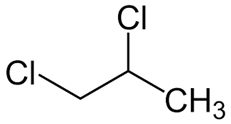 What is 1,2-Dichloropropane?
What is 1,2-Dichloropropane?
1,2-Dichloropropane is a colorless, flammable liquid with a chloroform-like odor. It is moderately soluble in water and readily evaporates into air. It does not occur naturally in the environment.
Uses
Propylene dichloride is used as a chemical intermediate in the production of chlorinated organic chemicals, as an industrial solvent, in ion exchange manufacture, in toluene diisocyanate production, in photographic film manufacture, for paper coating, and for petroleum catalyst regeneration. Propylene dichloride was used in the past as a soil fumigant for a variety of crops. This use has been discontinued, and pesticide formulations containing propylene dichloride are no longer available in the United States.
Sources & Potential Exposure
Propylene dichloride is used as a chemical intermediate in several industries. Acute (short-term) inhalation exposure to high levels of propylene dichloride by humans results in effects on the lungs, gastrointestinal system, blood, liver, kidneys, central nervous system, and eyes. Limited information is available on the chronic (long-term), reproductive, developmental, and carcinogenic effects of propylene dichloride in humans. Animal studies have reported effects on the respiratory system and blood from chronic inhalation exposure. Animal studies have reported developmental effects from propylene dichloride exposure by gavage (experimentally placing the chemical in the stomach). Animal studies have reported an increased incidence of mammary gland tumors in female rats and liver tumors in male and female mice given propylene dichloride by gavage.
Federal Regulations
EPA has provisionally classified propylene dichloride as a Group B2, probable human carcinogen.

 Americas
Americas Europe
Europe Français
Français Deutsch
Deutsch Italiano
Italiano Español
Español
